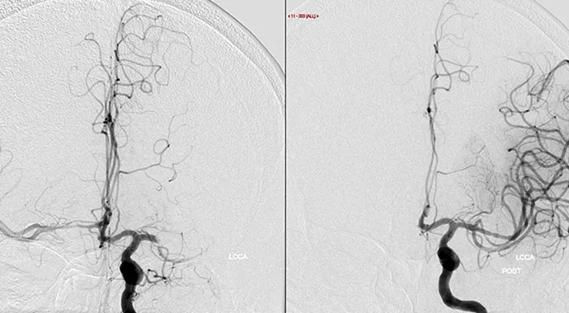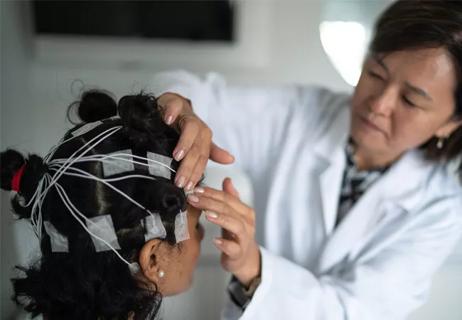$3.2 million grant will fund use of calcium-based imaging to record neuronal activity in ischemia model

When results of Cleveland Clinic’s first-in-human EDEN trial of deep brain stimulation (DBS) for post-stroke rehabilitation were published last year (Nat Med. 2023;29:2366-2374), they offered encouraging evidence of feasibility and safety and set the stage for an ongoing phase 2 study. Now Cleveland Clinic researchers are undertaking a preclinical research project to more fully elucidate the mechanistic underpinnings of how DBS contributes to post-stroke rehabilitation.
Advertisement
Cleveland Clinic is a non-profit academic medical center. Advertising on our site helps support our mission. We do not endorse non-Cleveland Clinic products or services. Policy
The new research is supported by a $3.2 million National Institutes of Health grant to Hod Dana, PhD (shown above), of the Department of Neurosciences in Cleveland Clinic Lerner Research Institute, who is collaborating with the EDEN trial’s principal investigators, Andre Machado, MD, PhD, and Kenneth Baker, PhD.
The work will utilize new methods and tools developed by Dr. Dana’s lab to record neuronal activity in the brain using advanced nonlinear microscopy and calcium imaging techniques in preclinical models.
EDEN was a single-arm, open-label, phase 1 investigation of DBS in 12 patients with chronic, moderate to severe hemiparesis of the upper extremity following unilateral middle cerebral artery stroke 12 to 36 months previously. In addition to receiving supervised physical rehabilitation, patients underwent DBS targeting the cerebellar dentate nucleus. The hypothesis was that stimulating the dentatothalamocortical pathway, which connects the cerebellum and cortex, would facilitate reorganization of the perilesional cortex after ischemic stroke.
In addition to demonstrating safety and feasibility of DBS across the 12-patient cohort, the study revealed a 7-point median improvement on the primary motor function endpoint of Fugl-Meyer assessment of upper extremity function. Nine of the 12 patients surpassed the threshold for a minimal clinically important difference in function.
A key aim of the new advanced imaging research led by Dr. Dana is to help illuminate why a subgroup of patients in the trial did not show functional response to DBS and to identify new strategies for making the treatment as effective as possible. “A better mechanistic understanding of how DBS may enhance functional reorganization of the perilesional cortex is central to such insights,” Dr. Dana says.
Advertisement
“The work with Dr. Dana’s group will enable us not only to further understand how stimulating the cerebellum alters cerebral cortical activity but also to visualize changes in those effects as a function of how we deliver stimulation,” adds Dr. Baker. “The latter may be crucial in helping us further optimize and enhance the effects as we shift toward a more patient-specific approach to delivering therapy.”
The central hypothesis of the new research is that patient-specific customization of DBS parameters, such as pulse amplitude and frequency, is needed to efficiently achieve excitation of the targeted brain regions and maximize the effectiveness of stimulation therapy.
“Our goals are to explore how reorganization of perilesional brain tissue following stroke is promoted by DBS and to develop an approach for patient-tailored DBS parameters to enhance recovery across a range of physiologically relevant conditions,” Dr. Dana explains.
He and his colleagues will use the endothelin-1 vasoconstriction rodent model of cortical ischemia to systematically vary stroke volume and assess various treatments. Additionally, they will use two-photon microscopy and calcium imaging in the rodent model to characterize brain activity across the cerebral cortex before and during recovery from injury. Calcium imaging enables display of activity in multiple neurons simultaneously, creating comprehensive maps of brain activity.
Dr. Dana notes that prior studies linking cortical excitability and circuit reorganization with enhanced motor recovery have failed to translate to clinical success, in part because of heterogeneity among patients and a lack of patient-tailored considerations in treatment application.
Advertisement
“We plan to address heterogeneity among subjects in a novel way,” Dr. Dana says. This involves monitoring DBS-induced increases in the firing rates of perilesional neurons in the post-stroke setting. Whereas prior studies used identical stimulation across animals, his group will adjust DBS parameters for each animal in order to achieve and sustain one of three target perilesional firing rates. “Beyond promoting recovery, this should minimize variability in tissue excitation among rats, which we believe will result in decreased heterogeneity in recovery,” he explains.
The researchers’ long-term aim is to translate their insights from the rodent model into similar interventions for patients. “We believe that identifying personalized indicators for successful recovery, and then integrating their evaluation into new treatment paradigms, will be crucial to improving quality of life in stroke survivors,” Dr. Dana says.
“We’re aiming to demonstrate a new subject-specific brain stimulation method in which functional brain activity data are used to fine-tune DBS parameters and thereby enhance rehabilitation outcomes,” he concludes.
Advertisement
Advertisement

Increasing treatment options are extending the window for continued functional gains

Study links large artery atherosclerosis and delayed presentation to poorer treatment results

Findings from large cohort analysis can guide ongoing quality improvement initiatives

Insights and what’s next for the first U.S. mobile stroke unit to treat patients

Research to test clinical efficacy and cost-effectiveness versus standard-of-care rehab

Times to target blood pressure, CT and medication administration shorter than with EMS transport

Many patients unnecessarily continue the medications for years

AHA scientific statement offers best practices to improve care for high-risk populations